

Apart from a chart and timeline of the events of 28 June 1914, there are photos and documents, and also on display are the clothes worn by Gavrilo Princip – and so is what must be regarded as the "prime exhibit": his gun used in the assassination. This may be of less interest to the purely dark tourist, but the section about the assassination itself makes up for it a bit. the Austro-Hungarian period of Bosnia (1878 to 1918). To get more information and see some artefacts, you have to visit the small museum at the very street corner that was the site of the assassination.Ībout three quarters of the museum's contents are about the historical period before the assassination, i.e. The Latin Bridge is across the road, and is a very pretty sight in itself – but it was not on that bridge that the assassination took place (as is often erroneously assumed). What there is to see: The assassination site itself is just a street corner, and a memorial plaque marks its historical significance. Incidentally, the actual car that Franz Ferdinand was travelling in that fateful day in Sarajevo, as well as his blood-stained uniform (!), are on display in Austria, namely in Vienna's Museum of Military History. It is mounted so low, close to ground level, that it is easily overlooked, though. The memorial plaque is now a sober factual statement: "From this place on JGavrilo Princip assassinated the heir to the Austro-Hungarian throne Franz Ferdinand and his wife Sofia". The war in Bosnia & Herzegovina in the 1990s brought change yet again: the footprint marker was removed or destroyed (there's conflicting information on this), the Bridge given back its old name Latinska ćuprija, and the museum, which suffered severe damage from shelling, wasn't restored for over a decade.Īfter the war, Princip went back to being regarded as a "terrorist", and the renovated former "Museum of the Sarajevo Assassination" was renamed "Museum of the Austro-Hungarian period (1878 – 1918)" when it opened in 2005, although outside on its walls it simply says "Muzej / Museum". Now even footprints were etched into the pavement to mark the spot were Princip had fired his fateful shots. A museum about the event was set up, and another new plaque unveiled. The pendulum swung back yet again after the partisans under Tito liberated the country from the Nazis and formed communist Yugoslavia – so Princip could once again be regarded as a national hero and pioneer of Yugoslavia's struggle for freedom. When the Nazis took Sarajevo during WWII, the memorial plaque for Princip was removed and he was even denounced as "Jew" (in that typical Nazi reflex). In other words, he was now rather regarded as a national hero (and Franz Ferdinand as a member of the former imperialist oppressors). Instead, the memory of the assassins was now celebrated and a memorial plaque erected that almost praised them – and the Latin Bridge was renamed after Princip. The Austro-Hungarian monument/shrine was later removed under Serbian/Croatian rule after World War One. The way the Sarajevo events of 1914, and the roles of Gavrilo Princip and Franz Ferdinand, were portrayed and commemorated afterwards bears witness to the changeability of attitudes towards and classifications of important historical events: first a pompously large monument/shrine to the Archduke was erected – while Princip was obviously denounced as nothing but a murderer.

Thus young Gavrilo Princip can be said to have shaped the course of history in the 20th century – although it is quite likely that war would have broken out anyway, given the political tensions and military mobilizations of the time. Alliances between various countries meant that soon after much of Europe was plunged into the extensive bloodletting that the "Great War" of 1914 to 1918 turned into. On an international scale, the assassination sparked off what was to become the First World War: when the Austro-Hungarians alleged some Serbian involvement in the assassination plot, this was used as the reason to declare war on Serbia. He was incarcerated at the Theresienstadt prison (which later gained even more notoriety as a Nazi concentration camp) under harsh conditions – from which he died less than four years later (from tuberculosis, to be precise). The assassins were all arrested – some were later executed, but Princip was too young for the death penalty and was thus sentenced to 20 years’ imprisonment.


 0 kommentar(er)
0 kommentar(er)
